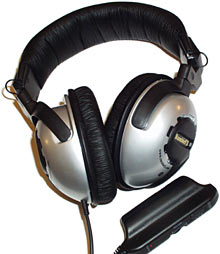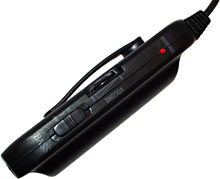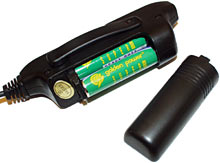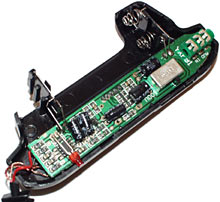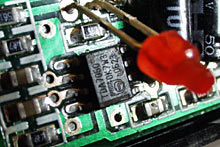
RumbleFX Force Feedback Headphones
Review date: 24 June 2001. Last modified 03-Dec-2011.
Let's get it out in the open right at the start.
The concept of "force feedback headphones" sounds just a little bit nuts, doesn't it?
That's how Evergreen Technologies describe their RumbleFX headphones, though. So what are they talking about?
They're talking about headphones with four transducers (things that turn electricity into sound) in them. Two for each ear.
One transducer in each pair is a normal headphone driver. The other is a "bass shaker", or "tactile transducer", which reproduces only the very low bass frequencies, down to a quoted five Hertz (Hz, cycles per second). That's well below the threshold of audibility. Canonically, humans aren't meant to be able to hear anything below 20Hz, and 5Hz is two octaves further down.
But you can feel sub-bass oscillations just fine, if they're powerful enough. The tactile transducers vibrate the headphone ear cups, and give you the impression that there's a big grunty subwoofer nearby, which for some reason is only shaking your ears, and not the rest of you.
Now, this isn't really force feedback, except perhaps in a rather broad sense. Force feedback implies that a computer's telling some peripheral or other to move in some direction or other, as when a force feedback steering wheel pulls against your hands as your virtual car corners, or when a force feedback joystick becomes stiffer and stiffer as your virtual plane flies faster and its control surfaces become harder to move.
Some other force feedback devices just buzz when the computer tells them to. Check out my review of Logitech's "iFeel" mouses here for a couple of examples.
A computer whose sound's being sent to RumbleFX headphones, though, has no idea that they're there. There's no driver to install, and no special support in games or any other software. You can, in fact, plug the RumbleFX 'phones into anything with a headphone jack, and they'll work the same. So you can listen to CDs or the radio or movies with RumbleFX sub-bass moving your lobes.
What you get
The list price of the RumbleFX package is $US59.99, but various places (linked to from this page on the RumbleFX site) are selling them for rather less. Buy.com has them for $US42.36, ex shipping, for instance.
For your money, you get the headphones themselves, a couple of AAA batteries to power the "Feedback Controller" with its built-in amplifier, and a four metre audio lead. The lead has a 1/8th inch stereo jack - as used on computer sound cards - at each end, and the Feedback Controller has a 1/8th inch socket on it. You plug one end of the cable into that, and the other end into the headphone socket of whatever you're listening to.
There's a 1/8th to 1/4 inch converter included, too, so you can easily use the RumbleFX 'phones with any normal headphone jack.
The Feedback Controller is a simple enough gadget, with a volume control, a red power light and a three-position switch. The switch lets you leave the amplifier turned off and just use the headphones in normal, non-vibrating mode, or turn the Rumble (and the power light) on in two steps, labelled I and II.
The amplifier hardware runs from the two included 1.5 volt AAA cells. They're installed both pointing in the same direction, but they're actually wired in series; the Feedback Controller runs from 3 volts.
When the Feedback Controller's turned on, according to Evergreen, a little digital signal processor in the Controller detects low bass signals and amplifies them selectively, sending the result to the bass shakers.
Using it
The all-hardware design of the RumbleFX 'phones means they're easy to set up. Just plug them in, with the bass switch on the Feedback Controller set to the "off" position, and they work as perfectly normal headphones. Click the bass switch to the I position and you get a moderate amount of "Rumble"; move the switch to the II position and you get rather more.
Setting the RumbleFX 'phones up for a given application can involve a certain amount of volume and bass setting twiddling, but it's not difficult to do.
How much Rumble you decide to use is up to you. You can do the standard university-student wind-everything-up-to-eleven thing, and make anything you listen to sound as if there's a goods train derailment happening nearby. Or you can go for a more realistic bass level.
In a proper subwoofer setup, the existence of the sub should only be noticeable if you turn it off; it shouldn't be bouncing cups off the coffee table all day.
But if life starts at 25Hz as far as you're concerned, there's nothing stopping you from having a go at shaking out your fillings. The RumbleFX package comes with a stern warning sheet telling you not to play anything too loud, and not to listen to headphones as you turn your computer on and off, lest power-up pops push your tympanic membranes out of your nose. But there is a long and glorious history to making everything louder than everything else, and, let's face it, one day you'll be dead, and your hearing's definitely going to deteriorate pretty fast then, isn't it?
The RumbleFX 'phones are fairly comfortable. They don't have the ear-squishing head-clamp feel of many cheap headphones, and the ear cushions are soft, though not really large enough to go right around the average ear. They're heavier than the average set of cheap circumaural headphones, but it's not a big deal.
The wire to the Feedback Controller, which is connected to the left ear-cup, is only just long enough for the thing to sit neatly in your lap. Since the Controller has noticeable mass, it's a tad annoying when it falls off and is suddenly dangling from the left side of your head. This is hardly a crippling problem, though.
Sound quality
My normal everyday headphones are a set of Sennheiser HD545s, which are very comfortable, sound very good, and cost quite a bit more than the RumbleFX setup. Sennheiser have replaced the 545 model with the HD570 now, and you won't find those for much less than $US130.
Everything about the 545s is lovely, if you ask me, except for the fact that they use Sennheiser's designed-by-a-monkey-with-a-Magna-Doodle spring terminals for their plug-in cables. These terminals are specially engineered to loosen and go intermittent and require poking and fiddling, and they make me angry. Very very angry. All the time. Fortunately, sweet liquor eases the pain.
Having the Sennheisers on hand for comparison is not a good thing, if you're reviewing ordinary "consumer" headphones, because nothing cheap sounds good by comparison.
This is not an obscure psychoacoustic audiophiles-only-need-apply difference; anybody without severe hearing loss can pick the difference between quality headphones and cheap ones. Just from the frequency response, if nothing else.
If you use the RumbleFX 'phones without turning the Rumble on - which you can do without even installing the batteries, if you like - they're nothing special.
Cheap headphones sound better than cheap speakers, but that doesn't mean they sound good. The RumbleFX 'phones have a pronounced midrange response hump, which, in English, means that they don't have as much bass and treble as they have midrange. I've heard plenty of worse 'phones than these, though. It wouldn't pain me to use these things all day, though I, unsurprisingly, much prefer my Sennheisers.
These, though, are not the headphones you use when you feel like hearing a spot of Vivaldi. These are the headphones you use when you want to put on your Juggernaut armour, balance a boom box the size of a refrigerator on your virtual shoulder, and crank up Funkstar De Luxe Vs James Brown to keep you company on the long and violent walk to the enemy base.
With the second set of drivers doing their thing, these headphones are indeed an aural experience unlike any other.
Well, except for other buzzing headphone models, that is.
Panasonic have made various models of headphones featuring their "Virtual Motion Sound System" (VMSS), which has recently been improved to the, wait for it, "Brain Shaker Extreme" version. This system seems to be much like the RumbleFX one, except it only works if you're plugging appropriately equipped headphones into Panasonic hardware that also supports VMSS. On the plus side, VMSS doesn't need batteries.
There's also at least one previous version of the RumbleFX 'phones - the TakStar force feedback 'phones that came with no-longer-available Xitel sound card packages.
Those headphones, made by international mega-brand Guangdong Takstar Electronic Co., Ltd, were very similar to the RumbleFX units, as you can see in reviews of the Xitel kit like the one at X-Bit Labs here. In fact, the RumbleFX 'phones seem to differ only in that they have just one cable going to the headset, while the old version had a cable on each side.
Assuming you haven't played with other models of vibrating headphone, though - and I hadn't - the RumbleFX experience is an interesting one. It's not as gimmicky as you might think.
Yes, it's basically just vibrating the ear cups in time with the bass, but it's not just a monotonal buzz. It does indeed feel like a really massive bass box playing only in the direction of your ears.
Basslines in music, explosions in games, special effects in movies; you name it, it gets bassified. With the bass switch in the II position, you get a substantial ear massage. These things should sell like wildfire on Ferenginar.
Computer game 3D positional audio through the RumbleFX 'phones is more realistic than it is through speakers, but the same can be said for any headphones.
Positional audio works better with headphones because there's much less crosstalk. When you use positional audio with speakers, the audio algorithms try to compensate for the fact that each ear can hear the speaker(s) on the "wrong" side as well as the sound from the "right" side. When you use headphones, the right ear can hear practically nothing from the left side.
So there's nothing great about the RumbleFX 'phones for games if you're interested in telling where sounds are coming from. But if you want every crash, explosion, rumbling engine and meaty-thud-of-crowbar-into-zombie to give your cranium a nice little shake, then these are the headphones for you.
Buzzes and rattles are death to anything that's meant to vibrate like crazy, and I'm happy to say that the RumbleFX 'phones do not emit any extraneous noises while they're palpating your pinnae. They're solidly screwed together, and the wires inside aren't over-long, and don't buzz against anything.
It's easy, though, to overdrive the RumbleFX amplifier - it's just a tiddly little thing powered by a couple of AAAs, after all. If you're listening at substantial volume to something that's already quite bass-heavy, the bass rumble will be accompanied by the nasty clipping sound familiar to anybody who's listened critically to a passing Korean-made hatchback with a very cheap bass box filling the cargo space, a quantity of loose panel trim, and an owner whose CD collection appears to be entirely composed of works with the word "Bass" somewhere in the title.
It's easy enough to deal with this distortion, though. Just turn the darn bass down a bit.
So what's doing this, exactly?
Glad you asked.
Inside
After a small amount of foam-peeling and screw-hunting, I got into the headphones and found this double-layer driver assembly. At the bottom, nearest to where your ear goes, is the normal headphone driver. Mounted on posts above it, and firmly coupled to the body of the headphone ear piece, is a second driver. That's the tactile transducer.
Here's the bass shaker with its back removed. This is the smallest one of these things I've ever seen, but it works like - and, actually, also looks like - the much larger units used in home theatre installations, arcade games and nuttier car stereos.
A bass shaker operates in much the same way as a normal electrodynamic loudspeaker. The shaking action comes from a "voice coil" which is springily mounted in a narrow gap in a powerful magnet. When current passes through the coil, it creates a magnetic field, and that field pushes the voice coil one way or the other, depending on the direction of the current. Send the coil electricity modulated by an audio signal and it'll vibrate in sympathy with that signal.
In a normal loudspeaker, the voice coil's connected to the speaker cone, and that lets it "couple" to the air, creating sound waves. The cone moves back and forth and creates the same compression and rarefaction waves that any object vibrating at the same frequency will.
In a bass shaker, there's no cone and rubber or paper cone surround; instead, there's the stiff yellow fibreglass "spider" you can see on the top of the shaker in the above picture, and the voice coil has a lump of metal connected to it. The spider lets the metal lump's oscillations shake the body of the transducer and whatever it's connected to, while still allowing the coil to move relatively freely.
So you get a smooth bass shake, like a small earth tremor, and not an obnoxious buzz, like a vibrating pager on a desk.
Here's the amplifier circuit board.
You might note a certain paucity of heat sinks, cooling fans, "WARNING: This amplifier's output can vaporise a crowbar!" stickers and similar signs of serious speaker-pushing grunt.
There's a reason for that. Like the Boostaroo headphone amplifier which I reviewed a while ago, the RumbleFX tactile transducers are driven by a very small low voltage power amplifier IC.
Actually, the Feedback Controller board uses the exact same IC as the Boostaroo.
Here it is - a Philips TDA7050, which from the three volts it's getting here is, according to its specification sheet, good for a rip-snorting 35 milliwatts at 10% total harmonic distortion.
The Boostaroo has three outputs and uses three TDA7050s; the RumbleFX uses only one.
One thing I didn't find on the RumbleFX circuit board was the "digital signal processor" that's alleged to be detecting bass. There's only one integrated circuit on the board, and it's the TDA7050. So I think the thing actually just uses a simple analogue low-pass filter; the lower the frequency, the better it gets through to the amplifier.
Frequency response
Every set of cheap headphones on the planet comes with a spec sheet which claims frequency response from, as they say, DC to daylight. The usually quoted range of human hearing is 20 to 20,000Hz, and that's what a lot of headphones say they reproduce.
Well, they do and they don't.
First - you can't really hear 20 to 20,000Hz. Different people have different ranges of hearing, high frequency response falls away as you age (14,000Hz is a more realistic upper limit, even for young adults), and there's no agreement on where the bass limit should be set, either. Low bass is felt more than it's heard; even profoundly deaf people can tell if there's a marching band bass drum being pounded nearby.
Second - pretty much any audio transducer will respond to pretty much any frequency of input signal. A dome tweeter will make some sound if you feed it a 30Hz hum. An 18 inch subwoofer will make some sound if you feed it a 15,000Hz whine. But neither driver will make very much sound, when they're fed a signal far outside their normal working range.
The output will be, in technical terms, strongly attenuated; if there are other frequencies in the input that are more appropriate to the driver type (which there will be, if it's music), then the driver will reproduce those frequencies much louder. Which will completely swamp the quiet out-of-range output.
So you can claim that a transistor radio's three inch speaker can reproduce 20 to 20,000Hz, if you like. It can, technically speaking. It just doesn't have enough efficiency at the upper and lower ends of that range for its response at those extremes to matter.
You need flat, even response, not just some response.
The fair way to evaluate transducer response is by quoting the "minus three decibel", or -3dB, points. Those are the points in the frequency-versus-output-power graph where the output power dips three decibels below its average value.
-3dB is half power. Anything less than half power, you're not going to be able to compensate for with frequency equalisation and still manage a normal listening level. Well, not unless you're using a rather peculiar speaker design - take a bow, Dr Amar Bose.
Evaluated according to these criteria, most cheap headphones are likely to have a response that's more like 70 to 14,000Hz or so, for full size models. Little in-ear 'phones may have a low -3dB point well above 100Hz, despite the fact that they almost invariably claim 20Hz (or better!) bass response.
Now, Evergreen quote a 5-28,000Hz response for the RumbleFX 'phones. That lower figure's preposterous for normal headphones, but more plausible for bass shakers. So I hooked the 'phones up to my audio signal generator and used my Mark 1A Ears to find out whether there was actually any response to speak of over that whole range.
Do the RumbleFX 'phones have real response at 28,000Hz? Probably not, since most headphone transducers don't, but I can't hear that high so I can't tell you. The highest frequency sound it's possible to record on a CD is 22,050Hz, anyway, so it's a bit of a moot point for most people.
Bass is easier to gauge, especially when it's vibrating your skull. The bass shakers in the RumbleFX 'phones started noticeably doing their thing in the mid-bass range above 100Hz, and they sang the same note as the plain transducers. Some bass accentuation systems have a frequency divider in them that makes the subwoofer or bass shaker play notes an octave below the input signal. The RumbleFX headphones don't do that.
There was plenty of buzz all the way down to about 38Hz, where it peaked noticeably. That's the resonant frequency of the little bass shakers, and it's pretty impressively low.
38Hz, which is about the frequency of the low D on a full piano keyboard, is the kind of resonant frequency you can expect from a quality eight or ten inch hi-fi woofer. This pitch is also likely to be somewhere near the dominant frequency of the average real kick drum. The drum sound on a lot of rock and dance music is tuned to sound better on smaller speakers, and has an energy peak up around 60Hz.
Transducers always lose response rapidly below their resonant frequency, though, and that's the case with the RumbleFX ones, too. At 31Hz - which is only a couple of tones lower than 38Hz - there was very little response left. And there was no perceptible vibration at all at 27Hz, which is the pitch of the A at the bottom of most piano keyboards.
The quoted 5Hz bottom limit is more than two whole octaves lower still; no way do these things have any response down there. Their real bass limit is maybe 35Hz, and that's being charitable.
For reference, the fundamental pitch of a 64 foot organ pipe like the one in the Sydney Town Hall organ is about 8.5Hz. That's not really a musical note. It's more of a small seismic event connected to a pedal.
Some CDs, movie sound tracks and computer games have bass that low. Most people won't, of course, ever be able to hear (or, more accurately, feel) it, because they don't have speakers or headphones that go that low. Generally, infra-bass isn't actually a desirable thing for a signal source to send to an amplifier. Commonly, everything below some arbitrary frequency is deliberately filtered out, to prevent speaker damage.
But even if your source material's got sub-30Hz bass, you won't feel it through the RumbleFX headphones, despite their alleged 5Hz rating. They actually give up at a considerably higher pitch.
I also noticed, listening to nice pure sine waves, that the RumbleFX amplifier seems to be doing things at frequencies well above what it's meant to pay attention to. Listen to, say, a 500Hz tone - just below the C above middle C - with the amplifier turned on, and there's a definite saw-wave harshness on top of the clean sine wave. It happens to everything from about 1000Hz down to real bass. Turn the amp off and the edgy odd-harmonics sound goes away.
This distortion isn't very subtle, but it's much easier to miss on normal source material, as opposed to one clean sine wave tone. You can hear it clearly enough on solo piano or vocal pieces, but it makes no perceptible difference to Ozzy.
If there indeed isn't actually a digital signal processor in the Feedback Controller (and, if there is one, I'm darned if I could find it!), that'd explain this behaviour. A low pass filter that lets too much midrange through to the high-distortion amplifier, to be poorly reproduced by the bass shakers, would probably make exactly the noise I heard.
Battery life
Evergreen quote a 30 hour battery life for the two AAA cells in the Harmonic Controller. I was interested to see whether that was plausible.
AAA alkaline cells have about 1000 milliamp-hours (mAh) of capacity, into a small load - if you draw one milliamp (mA) out of them, you're going to get a thousand hours of service. But they don't like delivering high currents. If the load is 100mA, you're going to get a lot less than ten hours of battery life.
When the Bass switch on the Feedback Controller's set to the off position, the amplifier board does nothing and there's no drain on the batteries. When the Controller's turned on but there's no signal, it draws about 11.4 milliamps (mA) with the bass switch in the I position or about 12mA with it in the II position.
Listening to rock music with a constant pounding bassline at moderate volume - quiet enough to be able to tell that someone next to you's trying to talk to you, though not necessarily quiet enough to be able to tell what they're saying - the amplifier draws about 30mA in I mode, or maybe twice that in II mode, on average.
With the 'phones running from AAA cells, 80mA seems to be about the current draw limit for reasonably low distortion listening.
You can get away with an amazing amount of distortion in sub-bass drivers as long as the voice coils aren't slapping their end stops, but anything that asked for much more than 80mA from the AAAs sounded clearly distorted to me. The real, nastily-distorted current draw limit seemed to be about 100mA.
If you're keeping to about a 30mA draw, then 25 to 30 hour battery life is pretty likely, particularly with the higher drain tolerance of current premium brand alkalines like Duracell's "Ultra" line and Energizer's "E2" products.
If you're pumping up the volume and drawing twice that much current on average, though, then a battery life below 10 hours is perfectly possible.
At high volume levels, the current draw of the amplifier caused the nominal three volts of the two AAAs to sag to about 2.7 volts, a number which'll get worse as the cells are flattened. Out of curiosity, I plugged the amplifier into my high current bench supply so it'd get a nice constant 3V.
Now, it could play noticeably louder without overly revolting distortion - 120 to 150mA didn't sound too awful. Unless you've got an unusually high power headphone amplifier, that's about as loud as you're likely to get the RumbleFX 'phones to play.
So, if you really dig the RumbleFX effect or just don't want to be changing batteries all of the time, hacking a regulated 3V plugpack's output onto the battery terminals could be an idea, for longer, louder listening. Or you could just connect a battery holder with a couple of C or D cells in it. Even AA cells have at least twice the capacity of AAAs, and better current tolerance; Cs will give you maybe 10 times the listening time of AAAs, and Ds will probably last 20 times as long.
Rechargeable AAA cells are probably not a great idea for the RumbleFX 'phones. Nickel-cadmium (NiCd) and nickel metal hydride (NiMH) rechargeables have much better current delivery ability than alkalines, but they've got lower capacity. And they only give you 1.2 volts per cell, which would limit the volume level you could use with the RumbleFX 'phones.
You can get 650mAh NiMH AAAs, and they'd probably last more than 20 hours at moderate volume levels. But for higher volume you'd need more voltage. The TDA7050 chip is rated for input up to six volts, so three cells delivering 3.6V would probably be fine - but that'd mean more fooling around, of course.
Overall
The RumbleFX site wants you to believe that these are "high quality headphones", even if you ignore the RumbleFX feature. Well, they seem to be constructed solidly enough considering their price, but their sound quality isn't as good as that from the average set of $US20 "digital monitor" 'phones from an electronics shop.
Its not the headphones' fault that they don't live up to the hype. Evergreen say, in a fine example of what happens When Marketing Attacks, that "audiophiles will appreciate the sound quality of the RumbleFX headphones, which - due to the enhanced sub-woofer and acoustically advanced physical design - is comparable to that of more expensive headphones ranging from $100 to $169".
Well, yes, it certainly is comparable. My cat is comparable to a tiger. He just won't fare very well in the comparison, unless things like the ability to hide behind an armchair are given a high weighting.
The RumbleFX 'phones don't sound revolting by quality-headphone standards, and they're not uncomfortable either. But sound quality is not their strong point. Sound quantity, specifically bass quantity, is what they're all about.
The RumbleFX headphones' appetite for AAA cells is a shade annoying, but it's not as if it's a disaster if you run out. If the batteries go flat in the middle of a marathon LAN game session, you can just turn the Rumble off and keep on playing.
If you want sound quality, you don't want RumbleFX. You can get 'phones that sound all right for considerably less than the price of mid-range Sennheisers like mine. Pretty much any set of name brand headphones that sell for the same price as the RumbleFX ones will sound clearly better.
But if you're in the mood for a techno-toy that'll tickle your ears, the RumbleFX headphones are a good choice. You can use them with anything, they work more or less as advertised, and they're not too expensive.
Now you'll have to excuse me. I am reliably informed that Peter Kruder and Richard Dorfmeister have been waiting for some time to push roughly half of my brain down my neck. Mustn't keep the lads waiting.
RumbleFX headphones kindly provided by Evergreen Technologies.
